2021-2022 年山东聊城高一英语下学期期末试卷及答案
C. He has to
B. In a library.
B. 8:55.
C. 9:00.
C. Watching sports on TV.
B. Watching YouTube videos.
B. He doesn’t get enough sleep.
第一部分 听力(共两节,满分 30 分)
做题时,先将答案标在试卷上。录音内容结束后,你将有两分钟的时间将试卷上的答案转
涂到答题卡上。
第一节(共 5 小题;每小题 1.5 分,满分 7.5 分)
听下面 5 段对话。每段对话后有一个小题,从题中所给的 A、B、C 三个选项中选出最佳选
项,并标在试卷的相应位置。听完每段对话后,你都有 10 秒钟的时间来回答有关小题和阅
读下一小题。每段对话仅读一遍。
1. What time is it now?
A. 8:40.
2. What is the man complaining about?
A. He has become a father.
take care of the sick baby.
3. What would the man stay up late for?
A. Doing his work.
4. Where does the conversation probably take place?
A. On a bus.
C. In a shop.
5. What are the speakers mainly talking about?
A. The abilities they want to have.
B. The ways to improve memory.
C. Their desire to learn dance.
第二节(共 15 小题;每小题 1.5 分,满分 22.5 分)
听下面 5 段对话或独白。每段对话或独白后有几个小题,从题中所给的 A、B、C 三个选项
中选出最佳选项,并标在试卷的相应位置。听每段对话或独白前,你将有时间阅读各个小
题,每小题 5 秒钟;听完后,各小题将给出 5 秒钟的作答时间。每段对话或独白读两遍。
听第 6 段材料,回答第 6、7 题。
6. What does the man do probably?
A. He is a student.
7. What will the man do on Sunday?
A. Help the woman.
听第 7 段材料,回答第 8 至 10 题。
8. When did the woman get the gift?
A. On Women’s Day.
9. What does the woman want next?
C. Earrings.
A. A ring.
10. What does the woman mean in the end?
A. She does not like rings.
B. She has not prepared well for marriage.
C. She might break up with her boyfriend.
听第 8 段材料,回答第 11 至 13 题。
11. What is the woman’s first suggestion?
A. Using less water in daily life.
B. Eating ai home as much as possible.
C. Watering the plants more often.
12. What does the woman do once a month?
A. She separates different types of garbage.
B. She cleans a neighborhood park.
B. Fix his car.
C. Write a paper.
B. He is a teacher.
C. He is a driver.
B. On her birthday.
C. On a normal day.
B. A hat.
�
B. Embarrassed.
C. Satisfied.
C. She collects newspapers.
13. What’s the probably relationship between the speakers?
A. Teacher and student.
B. Interviewer and interviewee.
C. Brother and sister.
听第 9 段材料,回答第 14 至 17 题。
14. How does the man feel about his job?
A. Bored.
15. What does the man do in his work?
A. He writes articles for the magazine.
B. He takes photographs of the models.
C. He carries the photographic equipment.
16. Where does the woman work now?
A. In a hotel.
17. What does the woman ask the man to do?
A. Recommend her to his company.
B. Get her a job in Spring Street.
C. Help her with photography.
听第 10 段材料,回答第 18 至 20 题。
18. How did the speaker travel around the South Island?
A. By motorbike.
19. Where is Christchurch?
A. On the east coast of New Zealand.
B. In the northwest of the island.
C. 150 kilometers north of Kaikoura.
20. Which of the following does the speaker want to see most?
A. Ocean birds.
第二部分 阅读(共两节,满分 50 分)
第一节(共 15 小题;每小题 2.5 分,满分 37.5 分)
阅读下列短文,从每题所给的 A、B、C、D 四个选项中,选出最佳选项。
C. In a restaurant.
B. In a bookshop.
B. By car.
C. By bus.
B. Dolphins.
C. Whales.
A
There are some great winter sports that are just waiting to be explored. Some
or more extreme than others, but still definitely worth a try...
Ice Skating
Invented more than 4000 years ago by the Finnish, it remains loved by so many
all over the world. People of all ages can take advantage of this fun sport, as it
is a great way to be outdoors and get a bit of exercise. Experts say that the more
you practice, the belter your balance, co-coordination, and flexibility will become.
So put on a pair of skates and get moving on the rink.
Snowcross
Snowcross is a sport suitable for people who are a bit more adventurous. Over
the last several years, snowcross has increased in popularity and is one of the most
sought-after forms of snowmobile races and a really trendy winter sport. Snowcross
is popular in the USA, Canada, Sweden, and Finland. Sound fun? Why not give it a
try?
Ice Hockey
Ice hockey is not just one of the most popular winter Olympic sports but has
also recently become a common international sport. Ice hockey is fast passed and
full of energy that also involved numerous intricate (复杂精细的) tricks and
movements. It doesn’t only have a competitive side, it also is super fun!
�
Snowboarding
Snowboarding is another really fun snow sport that is definitely worth trying
this winter. It’s not the same as skiing, the main difference between snowboarding
and skiing is that snowboarding does not use poles and most people use softer boots
for flexibility. Snowboarding has only recently been added to the winter Olympics.
There are hundreds of different resorts around the world that allow you to experience
this popular sport.
1. What can we know about Snowcross?
A. It needs more practice.
risks.
C. It covers numbers of tricks and movements. D. It is popular only in Europe.
2. Of the following sports, which is new in the winter Olympics?
A. Ice Skating.
Snowboarding.
3. What do the listed sports have in common?
A. They have a long history.
ages.
C. They are full of fun.
other sport.
【答案】1. B
B. It suits those willing to take
D. They are more extreme than any
B. They appeal to people of all
B. Snowcross.
C. Ice Hockey.
D.
2. D
3. C
B
Leonora Buenviaje has been making women’s clothes out of waste materials,
usually dresses. She says wearing clothes made from waste materials can be both
economical and look good.
Buenviaje is 51-years-old and from Cainta in the Philippines. To make her dresses,
she uses a foot-operated sewing machine (缝纫机) to join together the waste materials.
These include recycled newspapers, plastic wrapping and rice sacks. She creates new
and beautiful clothes women can wear. They are sometimes completed with a piece
called a headdress that goes on top of the head.
“The bubble wraps (气泡包装) from delivery packages are nice looking and make
for a good design, especially the black and white wraps,” she said. Bubble wrap
is a plastic product that is used to protect goods that are being delivered. She
said white bubble wraps were good for making wedding dresses. The dresses sell for
between $30 to $50. They are used for everything from coming-of-age parties for a
woman’s 18th birthday, called debuts (首秀), to weddings.
In Asia, there is plenty of waste material for Buenviaje to work with: about
80 percent of the world ocean plastic is estimated to come from Asian rivers. A 2021
report by Oxford University’s online publication, Our World in Data, found that
the Philippines is responsible for one third of Asia’s ocean plastic pollution.
“It’s important to recycle or utilize waste materials so we can help our
earths,” said Lalaine Alcalde, who buys clothes from Buenviaje. Buenviaje said the
recycled materials used for each dress depend on what her buyers are looking for.
4. What can we learn about Buenviaje from paragraph 2?
A. She likes wearing beautiful clothes.
responsible.
C. She made headdress from newspapers.
5. What are Buenviaje’s dresses designed for?
A. Modern weddings.
C. Special occasions.
6. What does the underlined world “utilize” in the last paragraph mean?
B. Protecting goods.
D. Reducing pollution in Asia.
D. She is creative and positive.
B. She is considerate and
�
C. Pick up.
B. Get rid of.
A. Make use of.
up.
7. Which of the following can be the best title of this passage?
A. Bubble Wraps: An Inspiration for Good Designs
B. Philippine Designer Makes Women’s Clothes Out of Waste
C. Ocean Plastic Pollution: A Threat to People’s Life
D. Philippine Designer Provides Recycled Clothes for Women
【答案】4. D
7. B
5. C
6. A
D. Clear
C
The legal age to drive a car in the United States is 16. Getting a driver’s
license on the day you turn 16 has long been a major life event for many young people
in America.
But interest in driving among today’s teenagers has dropped sharply over the
past 35 years. In 1983, 80 percent of 18-year-olds in America had a driver’s license
— the document that permits a person to drive a motor vehicle. By 2018, that number
had dropped to 61 percent. Among 16-year-olds, the number decreased from 46 percent
in 1983 to 25 percent in 2018.
Young people say they have many reasons for delaying or avoiding getting a
driver’s license. Some choose more environmentally friendly transportation choices.
Others find driving to be stressful. And some simply do not care about cars at all.
Carmakers want to make their vehicles more attractive to young people. They seek
to make cars more interesting to a generation raised on technology.
Mark Rushbrook is global director of Ford Performance Motorsports. “A big
screen” is what today’s teen drivers want, he said. “I think what is important
to them is staying connected in a safe way,” Rushbrook said. “The vehicle is an
extension (延伸) of their iPhone or their screen device, they want to stay connected
and bring their music and everything else with them into the car.”
B. By following the time line.
D. By making comparisons.
Mark Reuss is president of General Motors. He said he believes there is still
a market for young people who care about more than just their music and connectivity
(连接功能). “You still have to deliver connectivity in something people love to
look at and be seen in.” he said. “That generation has not been lost. They still
want a great looking car...” He added, “There’s lots of different ways to make
cars appealing and that doesn’t go away.”
8. How is paragraph 2 developed?
A. By giving examples.
C. By giving reasons.
9. Which can be a reason for young people avoiding getting driving licenses?
A. Feeling anxious when driving.
C. Not caring about the environment.
10. What can be inferred from Rushbrook’s words?
A. Smarter cars will attract teens more.
B. Cars with iPhones are being expected.
C. Music connectivity is the most important for teens.
D. The car screen will be bigger and bigger.
11. How does Mark Reuss say about young people?
A. They are not the biggest customers.
different ways.
C. They still want good-looking vehicles.
driving taste.
【答案】8. D
B. Lacking a sense of direction.
D. Hating public transportation.
D. They will never change their
B. They prefer to drive in
11. C
9. A
10. A
�
D
“We thought dogs would behave like children under age 5, but now we guess that
perhaps dogs can understand when someone is dishonest,” says Huber at the University
of Vienna in Austria. “Maybe they think, ‘This person has the same knowledge as
me, but is giving me the wrong information.’ It’s possible they could see that
as lying.”
Once that trust was established, the team had the dogs see another person move
the food from the first to the second bowl. The communicators (交流者) were either
in the room, and also saw the switch (转移), or were briefly absent and so apparently
unaware that the food had been switched. In either case, the communicators would
later recommend the first bowl, which was now empty.
In previous versions of this experiment with children under age 5, the
participants reacted in particular ways. They would typically ignore the
communicator who gave honest but misleading advice on where the food was. However,
if the communicator had been in the room and seen the switch, but still recommended
the first (now empty) bowl, young children were actually much more likely to follow
the communicator’s knowingly misleading suggestion.
This may be because the children trusted the communicator over the evidence of
their own eyes, says Huber.
The dogs in the new experiment, however, weren’t so trusting of lying
B. We can train dogs to act like
communicators, much to the researchers’ surprise, says Huber. Half of the dogs would
follow the communicator’s misleading advice if the communicator hadn’t seen the
food switch. But only one-third of dogs followed the communicator who had seen the
food switch and still recommended the now-empty bowl. These dogs simply went to the
bowl filled with food instead. “They did not rely on the communicator anymore,”
says Huber.
12. What do Huber’s words in paragraph 1 show?
A. Dogs won’t believe people any longer.
children.
C. Dogs are a lot cleverer than we thought.
friends.
13. What is paragraph 3 mainly about?
A. The communicator’s suggestion.
experiment.
C. The communicator’s purpose.
experiment.
14. Who would the dogs more likely trust according to the last paragraph?
A. The one who didn’t see the food switch.
C. The one who recommended the wrong bowl.
15. What can we conclude from the passage?
A. Dogs are cleverer than children under age 5. B. Dogs can sometimes tell when
people are lying.
C. We can train dogs to find food in different ways.
like dogs.
【答案】12. C
第二节(共 5 小题;每小题 2.5 分,满分 12.5 分)
阅读下面短文,从短文后的选项中选出可以填入空白处的最佳选项。选项中有两项为多余
选项。
B. The one who moved the food.
D. The one who saw the food switch.
D. The children’s reaction in the
13. D
14. A
15. B
D. Humans often treat dogs as
B. The dogs’ reaction in the
D. We should be honest
A few days ago, our school held a two-day food festival. Before the food festival
started, the school had set up tents and posted menus at the gate of the canteen
to attract students. ___16___
�
On the first day of the food festival, when the bell rang after the last class
in the morning, everyone rushed to the booths (摊位) in front of the canteen. ___17___
There was a long line in front of each booth. Everyone sweated in the burning sun,
but the heat didn’t stop the students’ enthusiasm for delicious food. Fortunately,
I bought a cup of milk tea that I had been longing for in just a few minutes. It
tasted even better than I had imagined!
___18___ Without any experience, I chose to try as much food as I could, which
gave me so much joy and satisfaction. For example, I fell in love with the crispy
durian pastry (榴莲酥) at first bite. ___19___ And I can still remember how exquisite
the craftsmanship (技艺) of making Indian pancakes was. However, what impressed me
most was in fact the “intangible cultural heritage on the tip of the tongue”.
It was everyone’s combined effort that made the activity such a big success,
and it is people’s love for food that made the festival special. Enjoy food, value
food, have a heart of gratitude and never forget the ones who have brought you up.
___20___
A. From this, I have learned how to cook well.
B. More and more people began to buy milk tea
C. This is what I’ve learned from the food festival.
D. As a dessert lover, I couldn’t wait to enjoy tasty foods.
E. Within a few minutes, the place was crowded with people.
F. It was the first time that I had attended the food festival at school.
G. What’s more, I still can’t forget the amazing look of smoky ice cream.
【答案】16. D
第三部分 语言运用(共两节,满分 30 分)
第一节(共 15 小题;每小题 1 分,满分 15 分)
阅读下面短文,从每题所给的 A、B、C、D 四个选项中选出可以填入空白处的最佳选项。
19. G
20. C
17. E
18. F
Last year, hundreds of people spent good money on an experience that they knew
would include crowds, discomfort and danger. Many would become ___21___, due to the
extreme cold and low air pressure, and a few would even lose their ___22___. Yet,
despite all this, by the end of the trip many were already planning to ___23___ For
these people, climbing Qomolangma is an experience like no other, making some feel
weak and others, ___24___.
British mountain climber George Mallory wrote of climbing Qomolangma, “What
we get from this ___25___ is just sheer joy... We do not live to eat and make money.
We eat and make money to be able to ___26___ life. That is what life means and what
life is for.” ___27___, Mallory would die on the mountain in 1924, although his
body would not be found until many years later.
In 2011, words ___28___ to those of Mallory were spoken by American mountain
climber Alan Arnette, who climbed Qomolangma in that year and was going to climb
other high mountains around the world. “It brings into ___29___ what’s important
to you.” He added. “There are a thousand reasons to ___30___ and only one to keep
going. You really have to focus on the one reason that’s most important and ___31___
to you. It forces you to look deep inside yourself and figure out if you really have
the physical, as well as mental, toughness to ___32___ when you want to stop.”
Psychologist Frank Farley has spent years studying people who jump out of planes
and drive fast cars, as well as those who climb Qomolangma. He referred to the
___33___ of these people as “Type T”, with the “T” standing for “thrill”.
Speaking to the LATimesabout the “Type T” personalities, Farley said, “They
don’t want to die and they don’t expect to die. “Research also suggests that our
___34___ to seek risks can be connected to how much we expect to benefit from the
result. With this in mind, are the benefits of climbing Qomolangma worth the ___35___?
�
B. sick
C. excited
B. useful
C. special
B. memory
B. save
B. Sadly
C. hopes
C. go
C. hopeless
B. interest
B. quit
B. fascinated
C. adventure
C. obtain
C. Disappointingly
It’s totally up to you.
21. A. nervous
confused
22. A. way
23. A. return
24. A. relaxed
powerful
25. A. story
26. A. enjoy
27. A. Significantly
Eventually
28. A. related
similar
29. A. existence
30. A. look forward
off
31. A. accessible
affordable
32. A. rise
33. A. personalities
34. A. goal
35. A. awards
injuries
【答案】21. B
C
第二节(共 10 小题;每小题 1.5 分,满分 15 分)
阅读下面短文,在空白处填入 1 个适当的单词或括号内单词的正确形式。
C. stand
C. manners
C. chance
C. risks
B. push
B. values
B. task
B. efforts
C. focus
C. turn around
25. C
34. D
26. A
35. C
B. unique
C. acceptable
B. effect
B. lie down
22. D
23. A
24. D
27. B
30. C
31. B
32. B
33. A
D.
D. lives
D. leave
D.
D. tour
D. extend
D.
D.
D. use
D. take
D.
D. turn
D. ideas
D. desire
D.
28. D
29.
Can you imagine turning your school into a farm? This is ___36___ students did
at Zhengzhou Foreign Language Middle School. Under the“double reduction”policy(双
减政策), students have many new clubs and after-school ___37___ (activity). One of
the most popular clubs ___38___ (be) the Happy Farming Club.
“At first I thought I could just grow some vegetables here,” said Zhang Xin,
a club member. “But ___39___ turned out that I also learned a lot about agriculture
and biology.”
After ___40___ (study) crops like wheat and garlic, students got the chance to
grow them. “My group tried growing leeks (韭菜).” said Zhang. “We first put the
roots underground. Then we ___41___ (cover) them with a thin layer of soil and watered
them. After this, we had a great sense of ___42___ (achieve). We hope the leeks can
grow strong!”
Other groups grew ___43___ (differ) things such as wheat and spinach(菠菜). To
tell them apart, students set up boards with the vegetables’ names on them. The
campus looks like a small farm now.
“In the 38 years of our school’s history, we are the first ___44___ (grow)
vegetables,” said Zhang. “This is really ____45____ special experience!”
【答案】36. what
37. activities
38. is
40. studying
41. covered
42. achievement
43. different
39. it
�
44. to grow
45. a
第四部分 写作(共两节,满分 40 分)
第一节(满分 15 分)
46. 在你校英语读书节来临之际,学生会将组织以“Reading Lightens Our Life”为题的
演讲比赛。请你写一篇发言稿参赛,内容包括:
1.阅读的现状;
2.阅读的益处;
3.你的呼吁。
注意:
1.写作词数应为 80 左右;
2.请按如下格式在答题卡的相应位置作答。
【答案】Good morning, everyone, I’m Li Hua. The topic of my speech is “Reading
Lightens Our Life”. Nowadays, with the Internet developing rapidly, many teenagers
are keen on mobile phones and the Internet to get information, which has become an
increasing trend. As a result, their interest in book reading drops greatly.
How can we get teenagers back to a normal life? I think that it is a good idea
to help them form the habit of reading. For one thing, reading can broaden teenagers’
horizons. For another, reading can deepen their understanding of the events
happening at home and abroad. Besides, reading can help to improve their writing
skills.
Let’s pick up a book and read! Thank you!
第二节(满分 25 分)
47. 阅读下面材料,根据其内容和所给段落开头语续写两段,使之构成一篇完整的短文。
One day in December, Alvin, 66, was deep in the woods in Louisiana, when something
caught his eye. As Alvin approached, he saw that the object was a broken balloon.
Attached was a piece of paper decorated with sparkly star stickers. It was a child’
s Christmas wish list.
“Dear Santa,” the handwritten note read. “My name is Luna. I am four years
old. I live in Liberal, Kansas. This year I have been nice. I would like candy,
Spider-Man ball, Frozen doll, puppy. With love, Luna.”
Alvin’s heart hammered in his chest. Ever since he was a child, he had dreamed
of this very scene. “I’ve always wanted to find one.” He believed this was his
childhood wish coming true. And he knew he was going to make Luna’s wish come true
too.
Liberal, Kansas, is more than 650 miles from his hometown. But Alvin’s wife,
Ann, was not discouraged by the distance. She posted a photo of the balloon and the
Christmas list on his Facebook page, asking for help locating the sender. Just in
a few hours, the number of people sharing her post creep into the hundreds, “My
hope grew into expectations,” Alvin says. “I knew we were going to find Luna.”
Meanwhile, Gonzalez, the mother of four-year-old Luna, had no idea that such
an effort was underway.
It had been a hard year for Luna and her family. As COVID-19 spread, they felt
lonely, scared, and separated. Before December, Gonzalez had come up with the idea
of having the girl send letters to Santa by balloon. She told her that Santa would
grab the balloons while he flew through the air on his sled (雪橇).
She took Luna outside to release their wishes to the universe.“Bye. balloons!”
Luna called, waving as the balloons floated away, sailing above the trees and into
the sky.
The family was enjoying a modest Christmas together when they heard a knock at
�
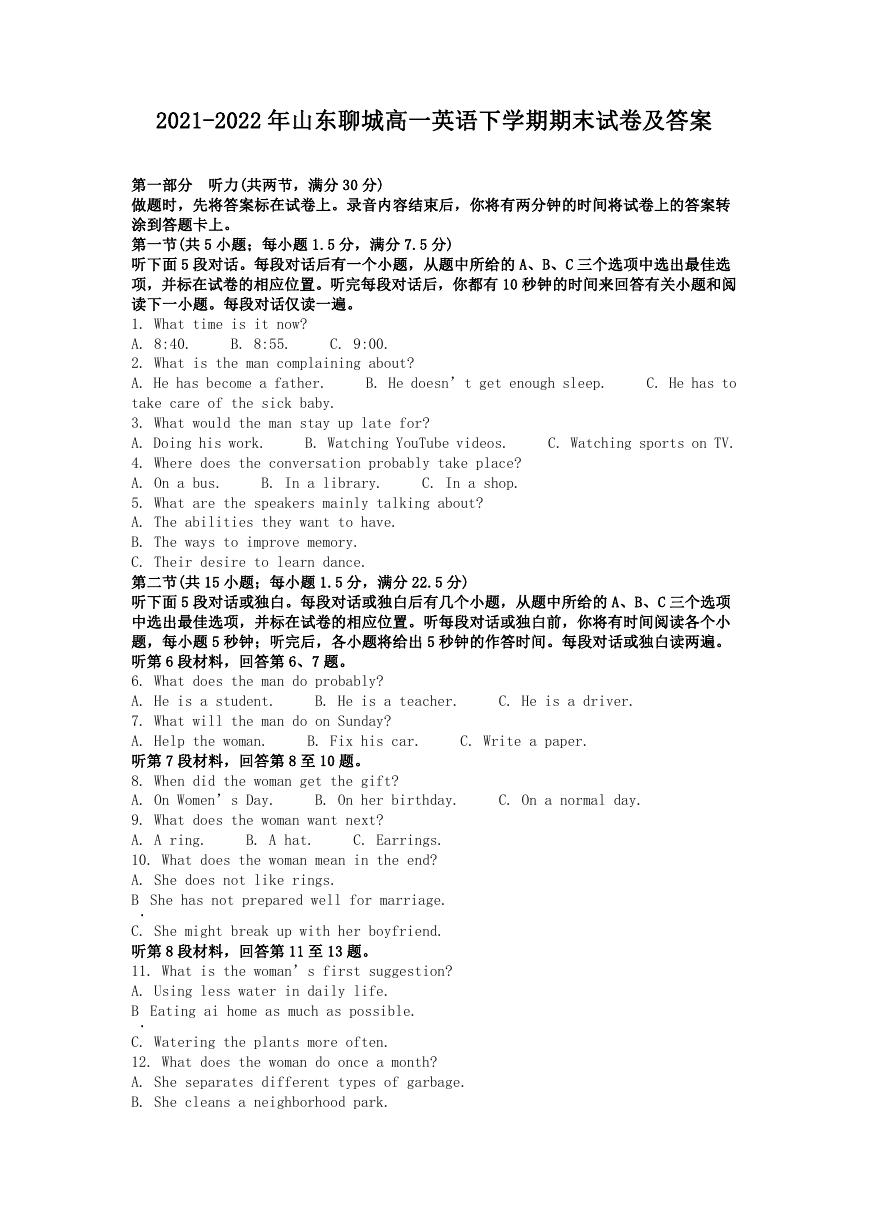
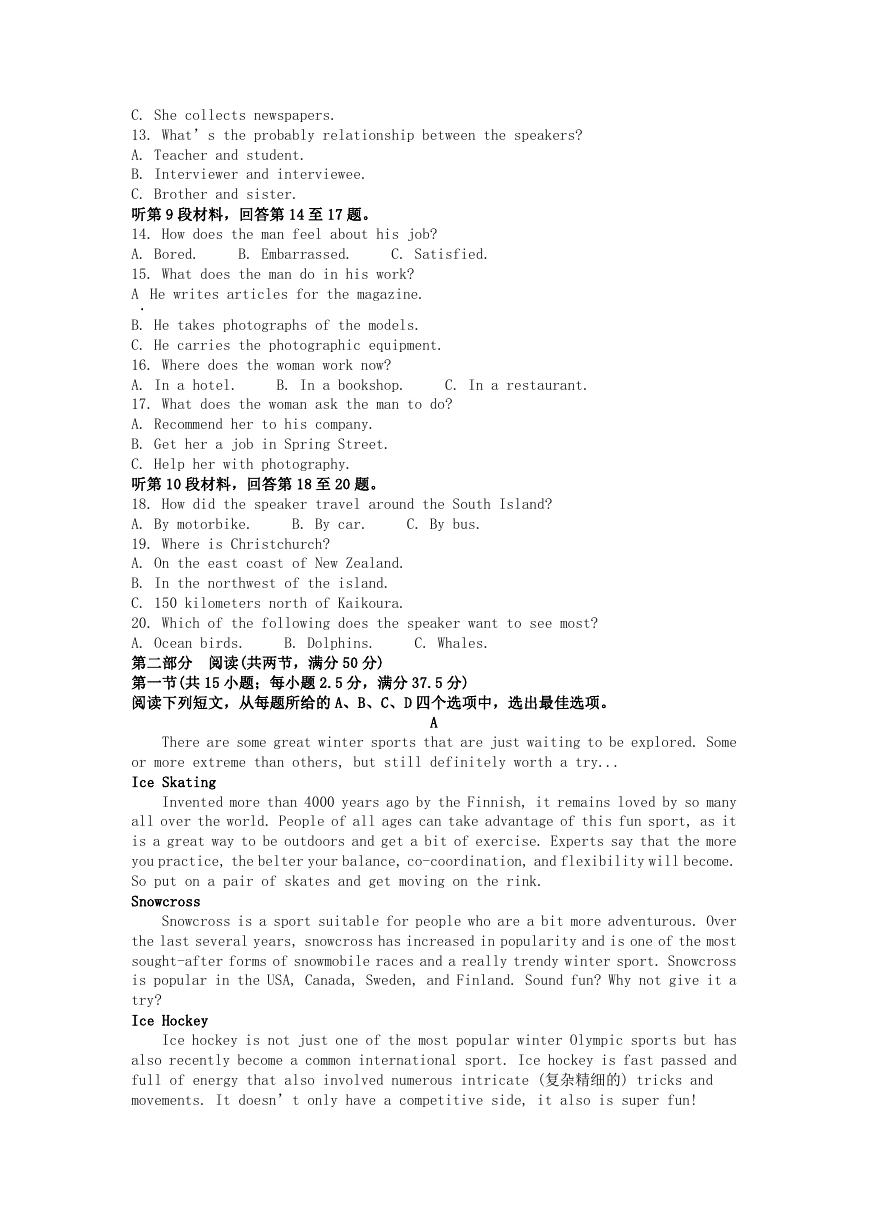
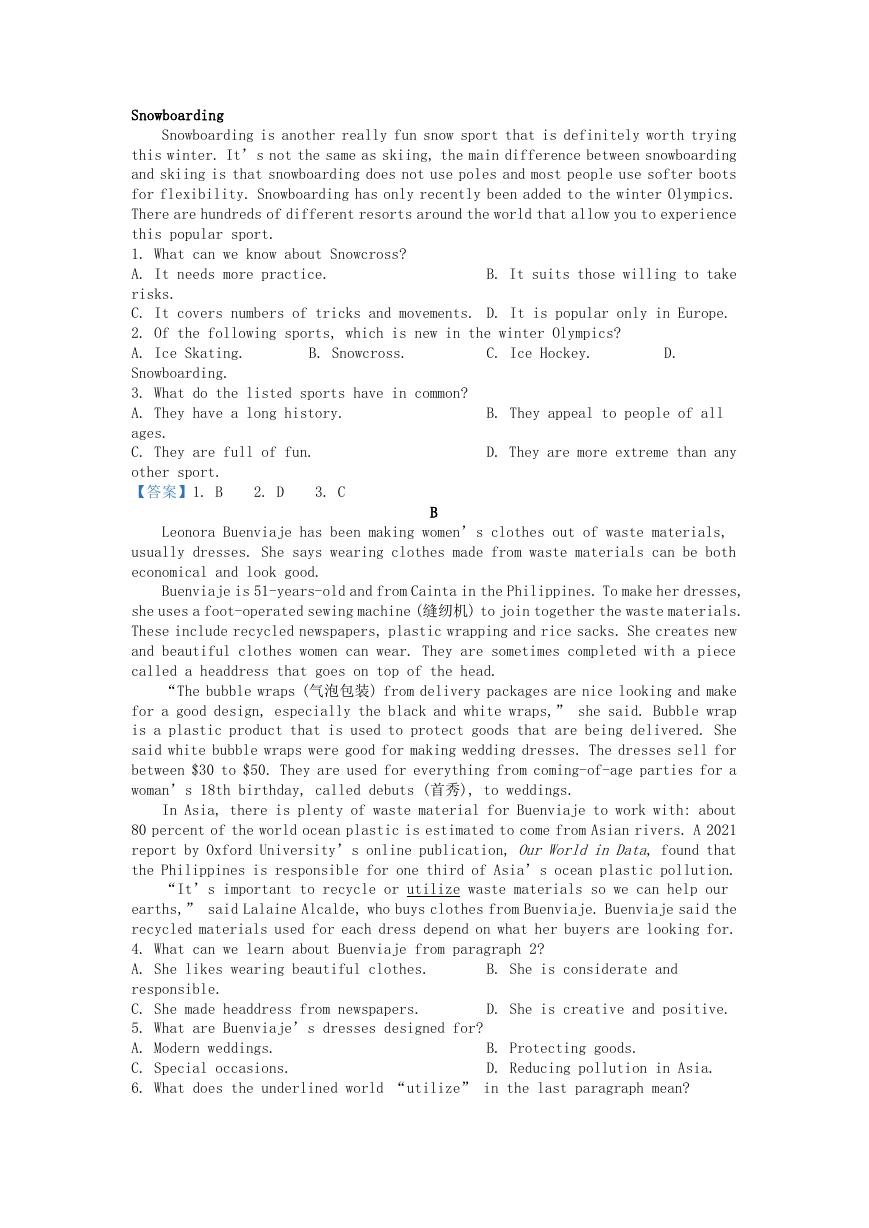
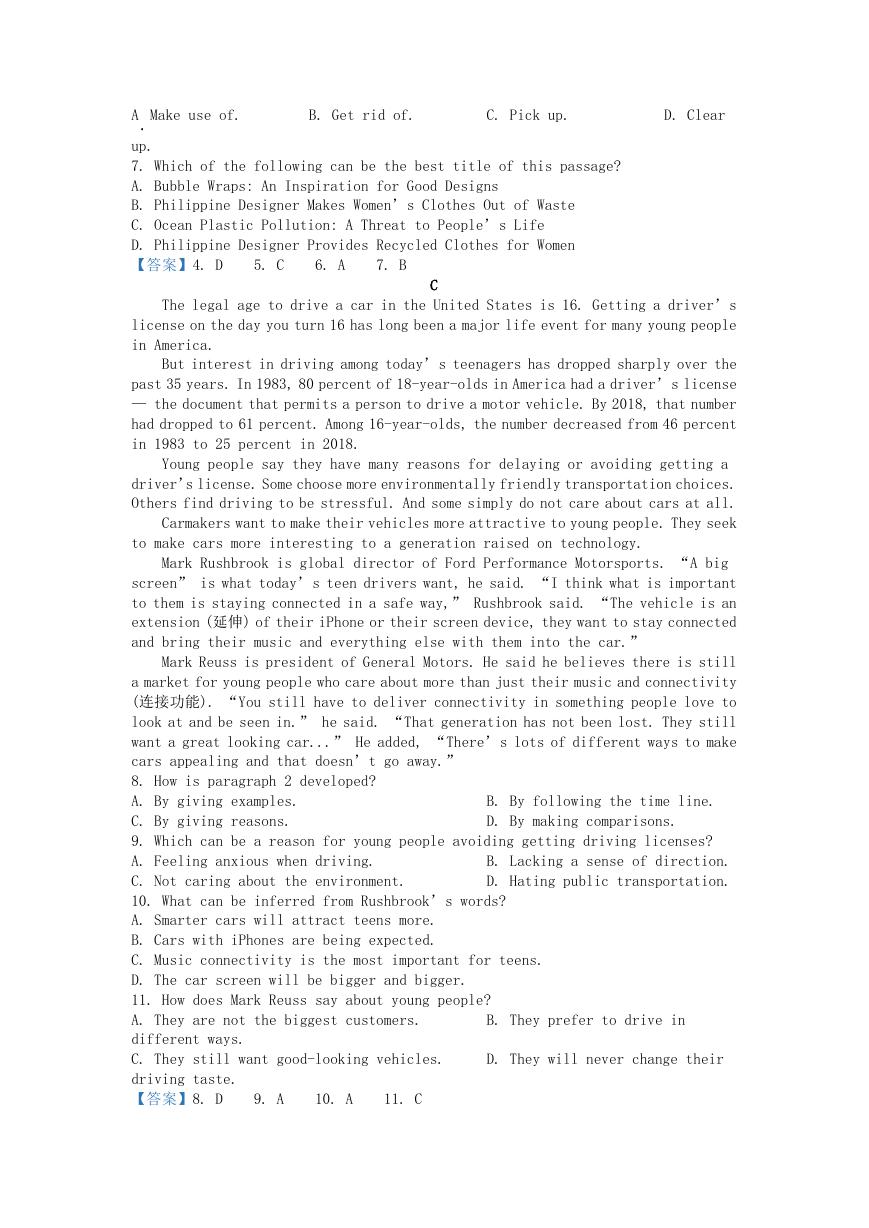
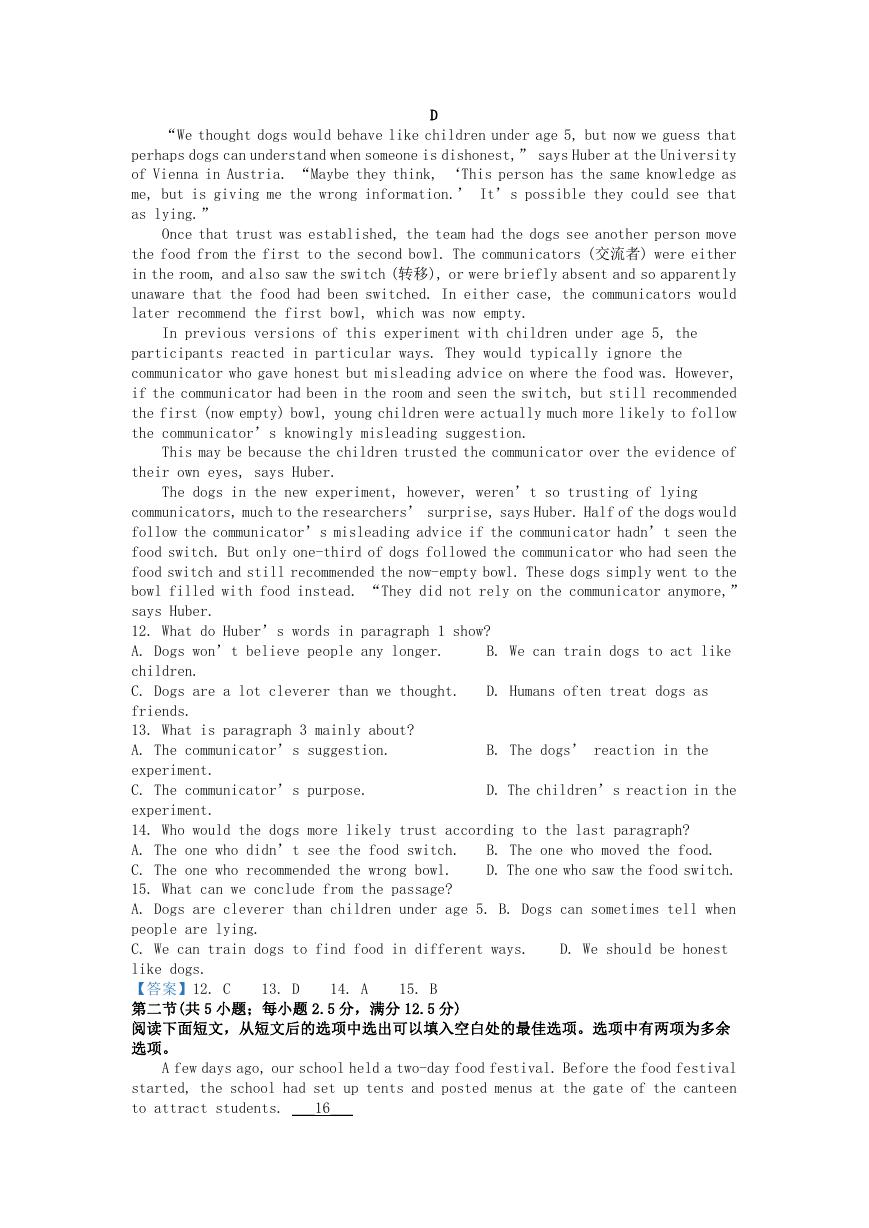
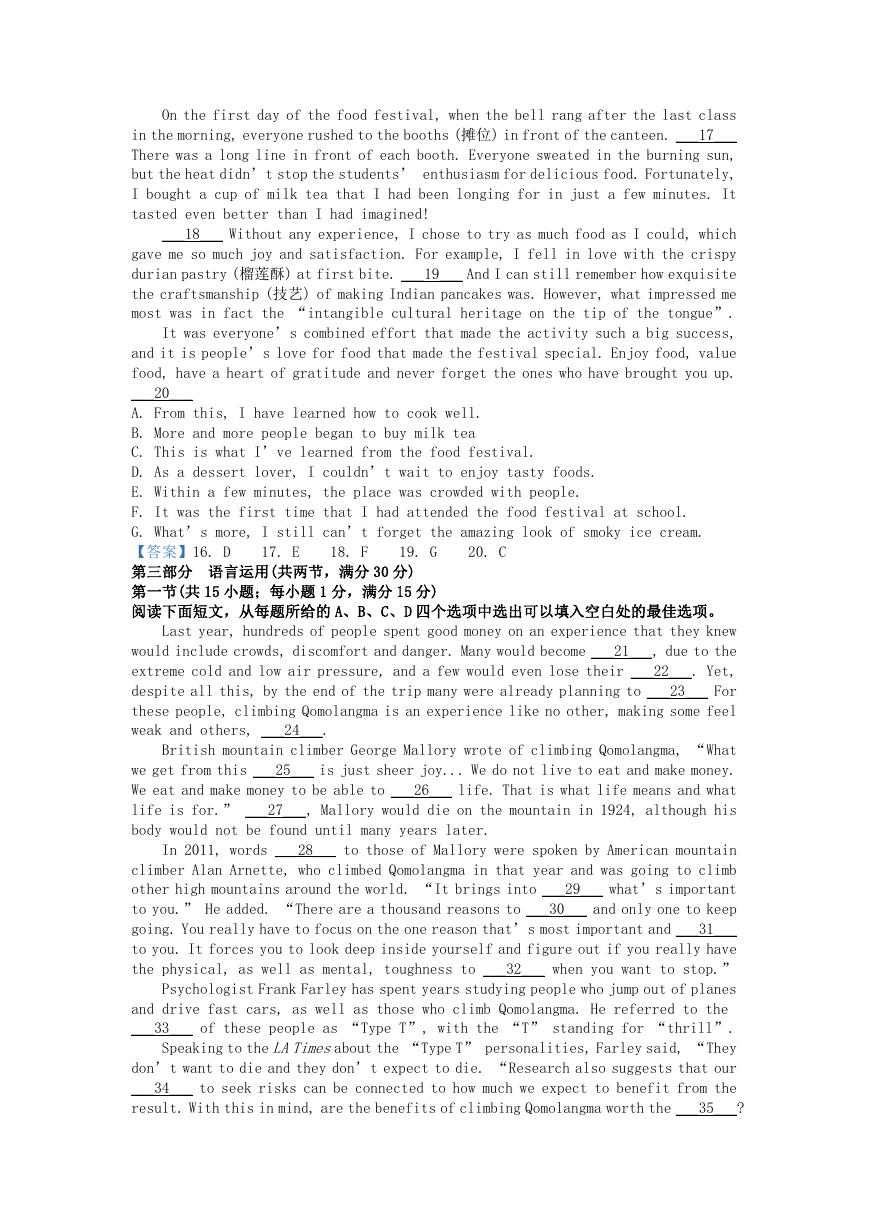
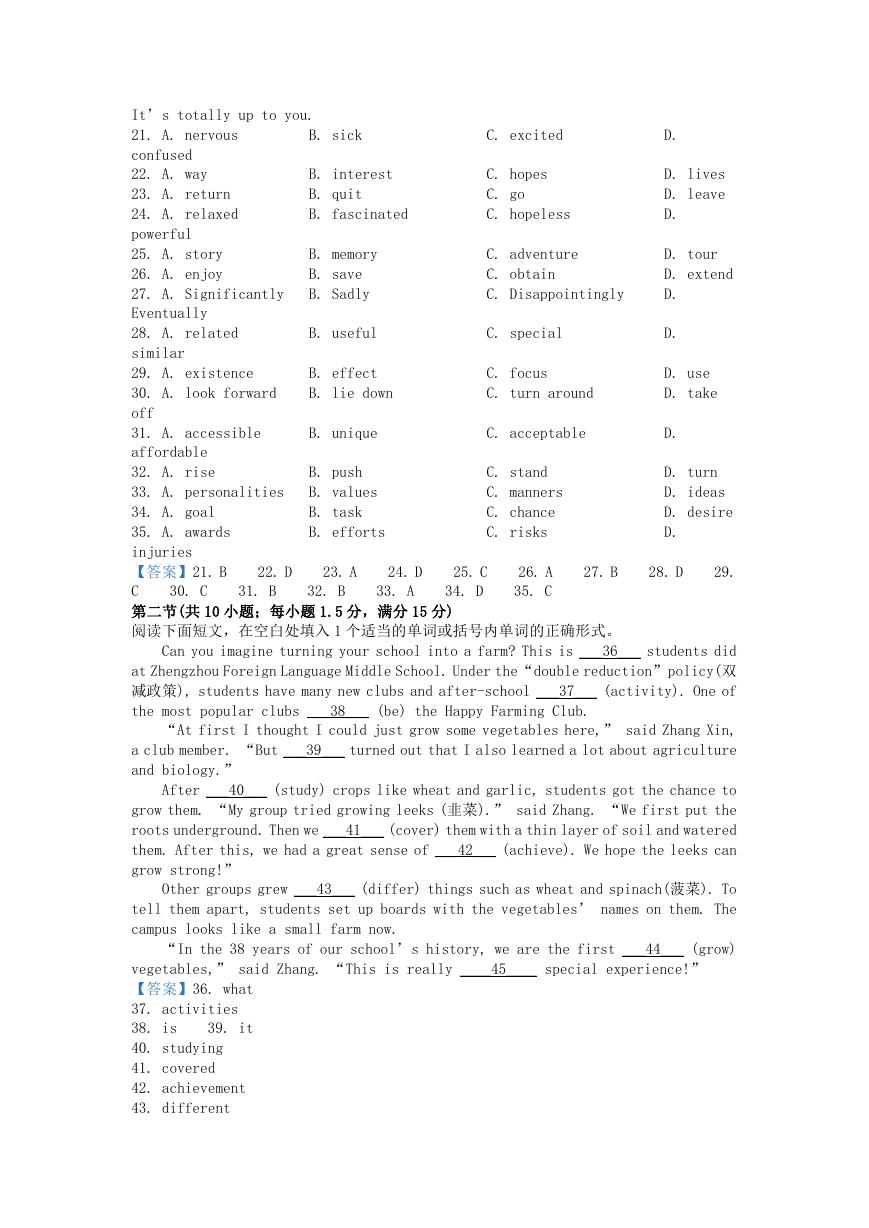









 2023年江西萍乡中考道德与法治真题及答案.doc
2023年江西萍乡中考道德与法治真题及答案.doc 2012年重庆南川中考生物真题及答案.doc
2012年重庆南川中考生物真题及答案.doc 2013年江西师范大学地理学综合及文艺理论基础考研真题.doc
2013年江西师范大学地理学综合及文艺理论基础考研真题.doc 2020年四川甘孜小升初语文真题及答案I卷.doc
2020年四川甘孜小升初语文真题及答案I卷.doc 2020年注册岩土工程师专业基础考试真题及答案.doc
2020年注册岩土工程师专业基础考试真题及答案.doc 2023-2024学年福建省厦门市九年级上学期数学月考试题及答案.doc
2023-2024学年福建省厦门市九年级上学期数学月考试题及答案.doc 2021-2022学年辽宁省沈阳市大东区九年级上学期语文期末试题及答案.doc
2021-2022学年辽宁省沈阳市大东区九年级上学期语文期末试题及答案.doc 2022-2023学年北京东城区初三第一学期物理期末试卷及答案.doc
2022-2023学年北京东城区初三第一学期物理期末试卷及答案.doc 2018上半年江西教师资格初中地理学科知识与教学能力真题及答案.doc
2018上半年江西教师资格初中地理学科知识与教学能力真题及答案.doc 2012年河北国家公务员申论考试真题及答案-省级.doc
2012年河北国家公务员申论考试真题及答案-省级.doc 2020-2021学年江苏省扬州市江都区邵樊片九年级上学期数学第一次质量检测试题及答案.doc
2020-2021学年江苏省扬州市江都区邵樊片九年级上学期数学第一次质量检测试题及答案.doc 2022下半年黑龙江教师资格证中学综合素质真题及答案.doc
2022下半年黑龙江教师资格证中学综合素质真题及答案.doc